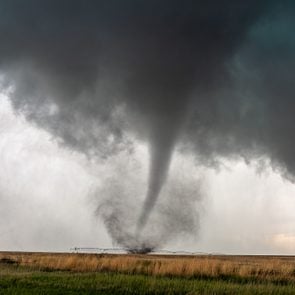Just How Dangerous Is It to Shower in a Thunderstorm? A Lightning Expert Explains
Updated: Sep. 26, 2023

When you stumble out of bed in the morning, do you head straight for the shower? We all have our morning routines. Mine is jumping in after I take the dogs on a run. The other morning, though, I saw the ominous signs of a storm on the horizon. Uh-oh. I love a good downpour as much as anyone, especially after our parched Texas summer, but can you shower during a thunderstorm?
I’d heard that showering is one of those things you should never do in a thunderstorm, but was it true or just a weather myth? Luckily, I knew just the expert to ask. Read on for this and other thunderstorm facts to keep you and your family safe.
Get Reader’s Digest’s Read Up newsletter for more safety tips, humor, cleaning, travel, tech and fun facts all week long.
Can you shower during a thunderstorm?
Technically, you can shower during a thunderstorm … but you really shouldn’t. “Metal plumbing and the water inside are both very good conductors of electricity from lightning that could strike the home or nearby,” according to Aaron Treadway, a lightning safety expert for the National Weather Service (NWS). That’s right—lightning doesn’t even have to make a direct hit to impact your plumbing. Your pipes extend outside your home and underground, giving lightning multiple routes of entry.
“Because of this, it is not safe to take a shower or bath, or wash your hands or do dishes, during a thunderstorm,” Treadway says.
What are the risks?
If you’ve never given a second thought to jumping in the shower while the skies are threatening, it’s high time you did. “Since the pipes and water can conduct the electricity from a strike,” Treadway says, “risks would be similar to being struck by lightning.” Yikes! What does that mean? Lightning strikes generally affect the nervous system, causing headaches, muscle soreness and dizziness in the short term, and possibly chronic pain and personality changes in the long term. And that’s if you’re not killed immediately due to cardiac arrest. According to the CDC, about 10% of people struck by lightning die from their injuries.
Now, the majority of lightning fatalities happen to people caught outside during a storm. (Treadway: “When thunder roars, go indoors!”) But incredibly, about one-third of all lightning strikes occur indoors. That’s mostly due to conduction—lightning traveling through metal pipes, wires and other conductive materials from outside your home to inside. The National Weather Service and the National Lightning Safety Council don’t track lighting injuries, only fatalities, but the risk is real. Treadway points to an indoor fatality in 2006.
And even if your chances of actually dying from a lightning strike while showering are remote, getting struck by lightning causes immediate injury and, potentially, lifelong health consequences. Do you want to take that chance?
What if your home has a lightning rod?
Don’t rely on a lightning rod to save you from a lightning strike while showering. “The primary purpose of a lightning rod is to divert the electrical charge from the lightning away from the home,” Treadway says. This is mainly to prevent fires, not to allow showering.
And remember that your pipes start outside too. Even with a lightning rod, there is still a chance that the energy could travel from outside to inside through the wiring or plumbing. Wait until the storm passes to jump in.
How do you know when it’s safe to shower?
Blue skies don’t mean the coast is clear. “If you are close enough to hear thunder—whether you are indoors or outdoors—you are close enough to be struck by lightning or have lightning impact you,” Treadway says. So-called “bolts out of the blue” can happen when there’s not a raindrop or storm cloud in sight.
So before you jump in the shower, listen for the thunder. Not only is the loud rumbling the reason dogs freak out during thunderstorms, but it can also give you a clue about when it will be safe to shower. Treadway says to wait for 30 minutes after you hear the last rumble. At that point, it’s OK to resume your normal outdoor and indoor activities, including showering.
“Waiting that half hour after you hear the thunder will give you a buffer from these bolts out of the blue,” Treadway says.
Thunderstorm FAQs
Now you know the answer to “Can you shower during a thunderstorm?” (No!) But what else can you do—or not do—during these common weather events?
Can you use a hair dryer during a thunderstorm?
Unfortunately, styling your hair will have to wait. (Hey, it’s probably raining outside, anyway.) Treadway emphasizes: “Anything plugged into the wall, like hair dryers or curling irons, should not be used during a thunderstorm!” Again, that’s because appliances and other devices connected to your home’s electrical wiring can potentially conduct a lightning strike. If you’re holding a hair dryer and the strike comes through the wiring from outside, you’re in trouble. Let your hair dry naturally when a storm’s brewing.
Can you charge your phone during a thunderstorm?
Nope. Sensitive electronics like phones and computers can be damaged by lightning strikes, and you can be hurt too. “Electrical surges caused by lightning can damage electronics even at some distance from the actual strike,” Treadway says, “and a typical surge protector will do little to protect the device (or the person using it) if lightning should strike.”
Treadway warns that the only way to completely protect vulnerable appliances is to unplug them, “but for your own safety, do this before the storm arrives.” (For more storm tips, here’s how to prep for a hurricane.)
Can you use a corded phone in a thunderstorm?
This one isn’t a great idea either. Corded phones (aka landlines) may be on their way out, technologically speaking, but the dangers are still with us. “While most homes no longer have them, using a landline/corded phone is dangerous during storms,” Treadway says. Remember the 2006 indoor fatality I mentioned earlier? “They were reportedly on the phone,” Treadway says, “based on our documentation.”
Luckily, cellphones are OK—as long as they’re not plugged in and charging. And cordless landline phones are safe too. Remember, it’s all about the wiring. If the device you’re holding is untethered to your home’s electrical system, you’re in the clear.
Can you drive a car during a thunderstorm?
Yes. “Being inside a home or in a car is the safest place to be during a thunderstorm,” according to Treadway. If lightning strikes your car, the energy will travel through the metal body of the car around you while you’re safe inside. Plus, if you’re at an outdoor concert, park or ball game, your car may be the closest and safest shelter. “Porches, picnic-table awnings and other open-air shelters are not safe,” Treadway says. That’s often where birds go during a thunderstorm, but don’t follow their example.
Can you use the toilet during a thunderstorm?
It might seem a little weird, but no. Just like you shouldn’t do the dishes during a thunderstorm, toilets are a no-go as well. It’s best to avoid anything involving plumbing. While it’s rare, there have been documented cases of toilets exploding during thunderstorms after lightning traveled through the buildings in which they were located.
About the expert
- Aaron Treadway is the Severe Weather Program Coordinator at the National Oceanic and Atmospheric Administration/National Weather Service headquarters in Norman, Oklahoma. One of his key roles is as the lightning safety subject-matter expert for the NWS.
Sources:
- Centers for Disease Control: “Frequently Asked Questions about Lightning”
- Centers for Disease Control: “Lightning Safety Tips”
- National Lightning Safety Council: “2006 Lightning Fatalities”
- National Weather Service: “Lightning Safety Tips and Resources”
- National Weather Service: “Lightning Science: Five Ways Lightning Strikes People”
- CNN: “Toilet Explodes After Lightning Strike”



